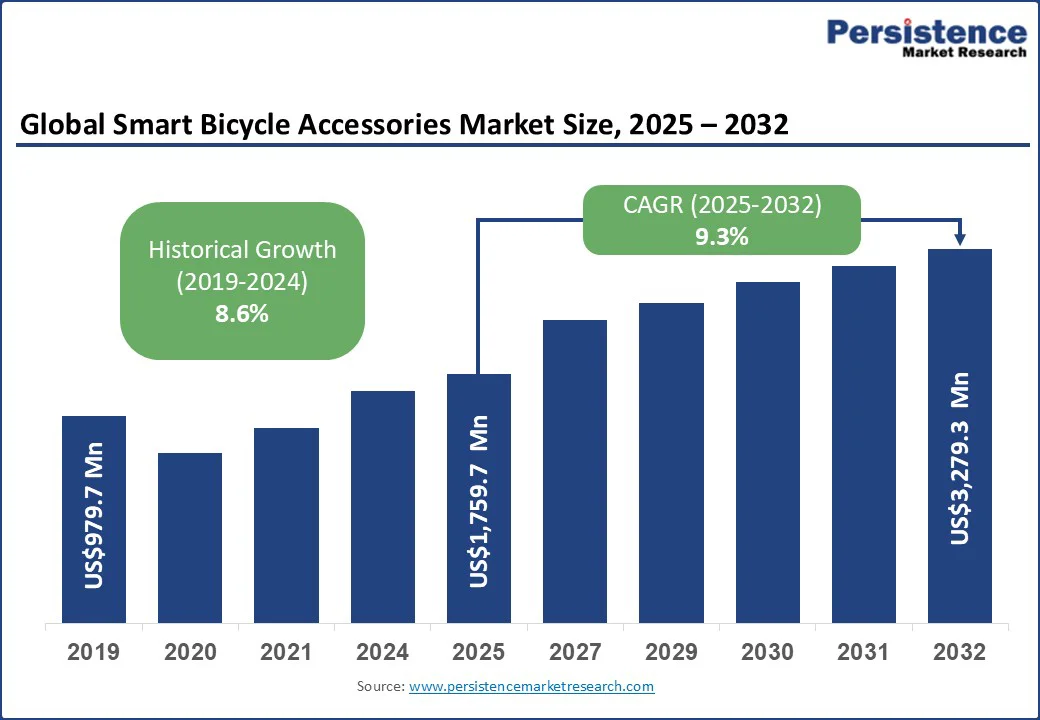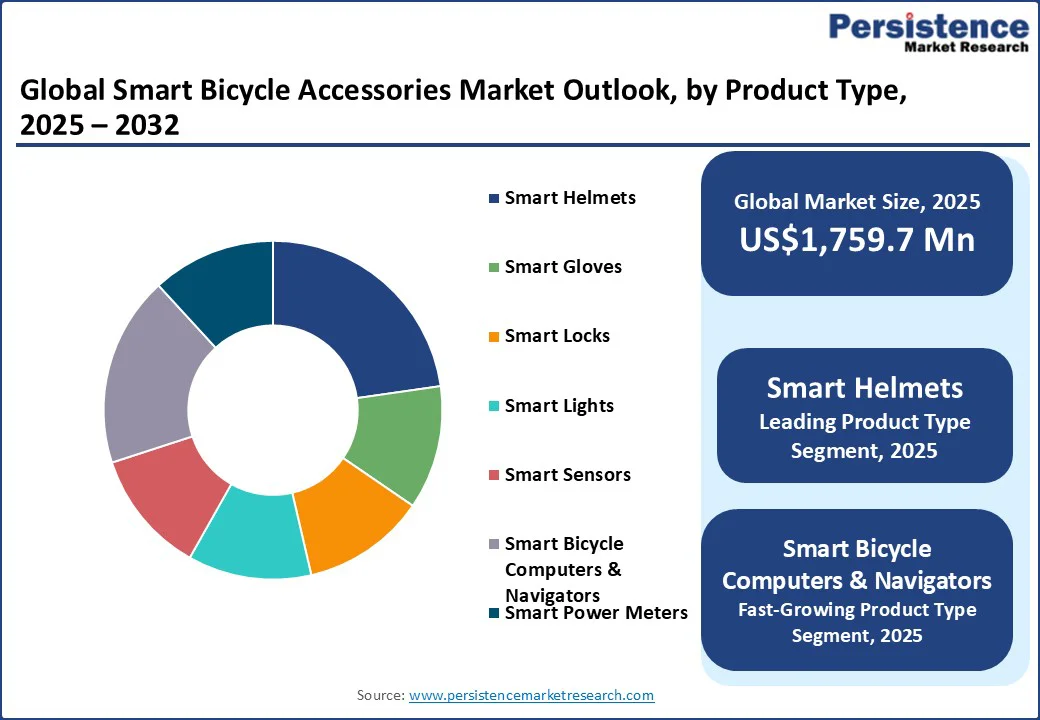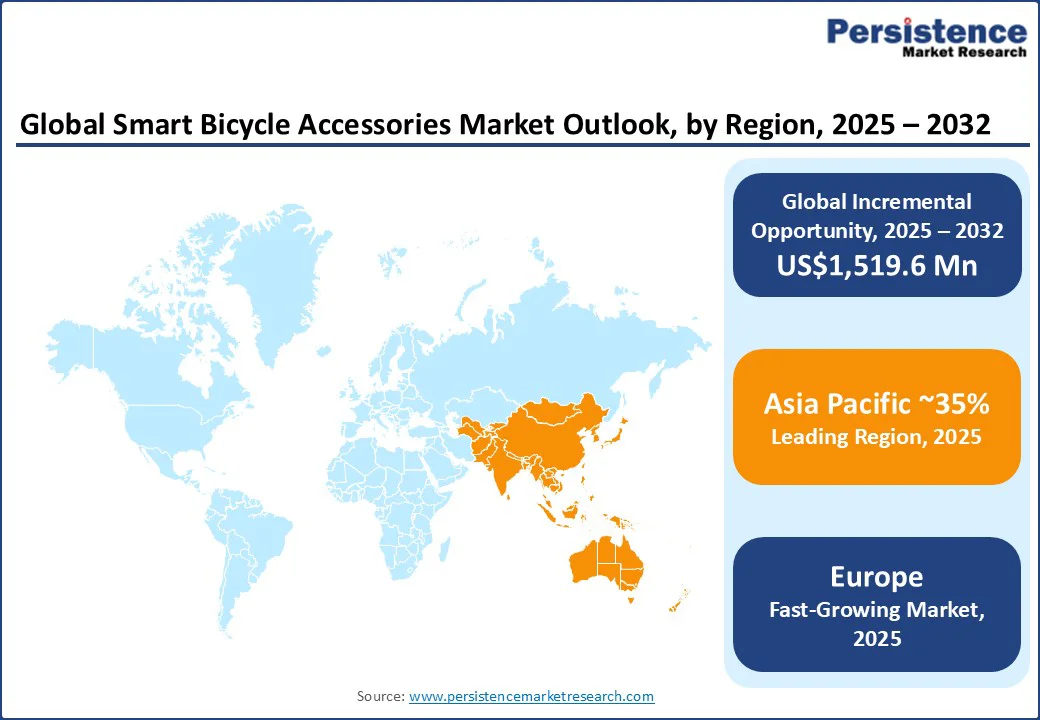ID: PMRREP18316| 183 Pages | 22 Sep 2025 | Format: PDF, Excel, PPT* | Automotive & Transportation

The global smart bicycle accessories market size is likely to be valued at US$1,759.7 Mn in 2025 and is expected to reach US$3,279.3 Mn by 2032, growing at a CAGR of 9.3%?during the forecast period from 2025 to 2032, fueled by rapid urbanization and rising environmental awareness. With cycling emerging as an eco-friendly transport choice, demand for products such as GPS trackers, smart locks, and fitness monitors is increasing.
Key Industry?Highlights

| Key Insights | Details |
|---|---|
| Smart Bicycle Accessories Market Size (2025E) | US$1,759.7 Mn |
| Market Value Forecast (2032F) | US$3,279.3 Mn |
| Projected Growth (CAGR 2025 to 2032) | 9.3% |
| Historical Market Growth (CAGR 2019 to 2024) | 8.6% |
The growing adoption of electric bicycles (e-bikes) is a significant driver for the bicycle accessories market. E-bikes offer a convenient and eco-friendly alternative for urban commuting, recreation, and even logistics, making them increasingly popular among various demographic groups.
Accessories tailored for e-bikes, such as battery chargers, performance monitors, and safety gear, are witnessing robust demand as consumers seek to optimize their riding experience. Governments worldwide are also supporting e-bike adoption through subsidies and infrastructure investments, indirectly boosting accessory sales.
The growth of e-bikes is particularly evident in urban areas, where e-bikes address traffic congestion and environmental concerns. As technological advancements continue, the market for high-tech accessories such as GPS systems, integrated lighting, and app-enabled security features is expanding, further cementing the role of e-bikes as a key growth driver.
The growth of the smart bicycle accessories market is restrained by inadequate cycling infrastructure in many developing regions. Limited investments in dedicated bike lanes, parking facilities, and safe commuting spaces make it difficult to promote cycling as a mainstream transportation option. This lack of infrastructure not only slows the adoption of bicycles but also reduces demand for smart accessories such as GPS trackers, smart locks, and safety devices.
Concerns over road safety in traffic-congested areas further discourage potential riders, hindering market expansion. To overcome this challenge, collaborations between manufacturers and policymakers are essential. Enhancing cycling-friendly infrastructure, alongside awareness campaigns, can significantly boost adoption and create favorable conditions for the widespread use of smart bicycle accessories.
GPS-enabled bicycle computers and navigation devices equip cyclists with accurate mapping, turn-by-turn guidance, and advanced route planning. They also monitor key performance metrics, including speed, distance, elevation, and ride history, enhancing both navigation and exploration.
For example, Garmin launched the Edge 1040 GPS bike computer featuring solar charging, multi-band GNSS technology, intercom functionality, adaptive bike lighting, Bluetooth-enabled smart locks, and specialized smart gloves designed for comfort and safety.
The integration of AI and IoT is revolutionizing customization, enabling seamless connectivity between bicycles, smartphones, and other smart devices. AI-driven insights further enhance performance and safety by analyzing user data and environmental conditions.
Additionally, the use of lightweight materials is improving cycling efficiency and speed. Collectively, these innovations are reshaping cycling culture and accelerating the growth of the smart bicycle accessories market.
In 2025, smart helmets account for nearly 32% of the smart bicycle accessories market, highlighting their vital role in the global cycling industry. Beyond head protection, their stylish design and comfortable, lightweight fit make them highly appealing to consumers. These helmets are equipped with advanced features such as location tracking, smart safety lights, turn signals, and action cameras, enhancing both safety and convenience for riders.
Night cycling challenges are addressed through integrated LED lights that improve visibility and alert other road users to cyclists’ movements. Technological innovations have further enabled Bluetooth connectivity, built-in speakers, and health monitoring functions such as heart rate and speed tracking.
The demand for smart helmets is fueled by the integration of communication systems that allow hands-free calls during rides and access to real-time performance data. This combination of safety, style, and technology positions smart helmets as a cornerstone of the smart bicycle accessories market.
Online sales channels have become the leading platform in the smart bicycle accessories market, fueled by the convenience of e-commerce, wide product availability, and competitive pricing. In recent years, the share of online sales has expanded rapidly, outpacing traditional outlets such as specialty retailers and department stores.
Major e-commerce platforms such as Amazon and eBay, along with dedicated cycling accessory websites, provide consumers with the ease of home delivery and access to extensive product catalogs.
Features such as detailed product specifications, customer reviews, and frequent discounts further enhance consumer confidence and support informed purchasing decisions. This shift toward online retail is significantly shaping the smart bicycle accessories market by improving accessibility, expanding global reach, and aligning with modern consumer shopping preferences.
Department stores contribute by reaching a broader customer base, displaying smart bicycle accessories alongside other consumer products, thereby increasing visibility and accessibility. Direct sales remain vital for brands seeking to build stronger customer relationships and brand loyalty.

Asia Pacific is projected to emerge as a dominant region in the market, supported by its 50% share of the global bicycle market in 2025. Home to over 60% of the world’s population, the region generates significant demand for bicycles and related accessories, particularly in rapidly developing economies.
The Chinese Ministry of Housing and Urban-Rural Development promotes the construction of urban bicycle and pedestrian transportation systems to build cycle-friendly cities. In Beijing, in 2019, a 6.5 km long cycling-only road named “bicycle highway” was opened. For the past couple of years, China has been facing the issues of rising air pollution levels and traffic congestion. The frequent conflict between cyclists and motorists creates the need for smart accessories in China.
India is also experiencing rapid growth, with bicycle sales reaching 10.67 million units in 2023-24, alongside imports of US$149 Mn and exports worth US$364 Mn. Rising urbanization, traffic congestion, and pollution are accelerating demand for smart solutions.
Government initiatives, such as India’s “National Electric Mobility Mission Plan (NEMMP)” and China’s “Action Plan for Green Mobility,” are further boosting the adoption of smart bicycle accessories through infrastructure development and green mobility promotion.
Europe is emerging as a global leader in the market, supported by the rapid adoption of e-bikes, strong policy frameworks, and extensive cycling infrastructure investments. Paris, for example, has allocated €250 Mn (US$267.5 Mn) to develop 180 km of bike lanes, resulting in a 166% increase in cycling traffic and driving demand for advanced accessories such as smart helmets, GPS devices, and connected locks.
Copenhagen, with over 400 km of cycling lanes and its ambitious goal of achieving carbon neutrality by 2025, positions e-bikes and related smart accessories at the center of its mobility strategy.
Germany and the Netherlands are leading markets, with Germany recording sales of more than 2.3 million e-bikes in 2023, while e-bikes account for over 50% of all bicycle sales in the Netherlands. This strong e-bike penetration fuels the need for innovative smart accessories that enhance safety, connectivity, and riding efficiency across Europe.
The Netherlands is known for its cycling culture, as it is the only country that has a greater number of bicycles than its population. Bicycles are used as a replacement for public transport and passenger cars. The country has a 35,000 km bicycle track. Also, the government supports cycling commuting by providing bicycles to children from poor families.

The global smart bicycle accessories market features a wide variety of products that enhance cycling by merging technology with traditional gear. With rising global interest in cycling, fueled by health awareness and environmental sustainability, demand for smart accessories is growing steadily. The market spans GPS trackers, smart helmets, advanced bike lights, and fitness monitors that appeal to both casual riders and professional cyclists.
Innovation and technology integration are key competitive factors, as consumers increasingly prioritize safety, performance, and connectivity. Companies must remain agile and responsive to evolving trends to capture market share. Fitbit has established itself as a strong player, leveraging its expertise in fitness tracking to create precision-driven cycling accessories that monitor speed, distance, and calories, delivering accurate performance insights for riders.
The smart bicycle accessories market is estimated to be valued at US$1,759.7 Mn in 2025.
The key demand driver for the smart bicycle accessories market is the rising adoption of connected and technology-enabled cycling solutions that enhance rider safety, convenience, and performance monitoring.
In 2025, the Asia Pacific region is expected to dominate the smart bicycle accessories market with a revenue share exceeding 35%.
Among the product types, the smart helmets segment is anticipated to dominate, capturing around 32% of the market revenue share in 2025.
The key players in the smart bicycle accessories market are Garmin Ltd., Polar Electro, Pioneer Corporation, Assize Technology Co., Ltd., and Robert Bosch GmbH.
| Report Attribute | Details |
|---|---|
| Historical Data/Actuals | 2019 - 2024 |
| Forecast Period | 2025 - 2032 |
| Market Analysis | Value: US$ Mn |
| Geographical Coverage |
|
| Segmental Coverage |
|
| Competitive Analysis |
|
| Report Highlights |
|
By Product Type
By Sales Channel
By End-users
By Region
Delivery Timelines
For more information on this report and its delivery timelines please get in touch with our sales team.
About Author